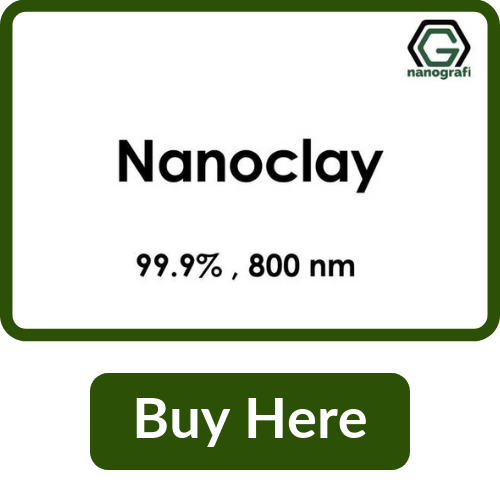Nanoclay: Properties, Production, Applications
Nanoclay is a component composed of phyllosilicates, which are compounds based on the elements of oxygen, silicon, and other components and are degraded from natural sources and pretreated chemically. After further processing steps, Nanoclay is used in different products. Due to their layered structure, they can swell or shrink as wateraccumulates or is withdrawn between layers. It is possible to increase the volume of nanoclay up to six times by water absorption and form stable gels. Nanoclay has unique properties due to which, its uses can be found in different sectors such as to convert desert sand into fertile land. In this article, we’ll see what is Nanoclay and how it is used for different purposes.
Structure of Nanoclay
Nanoclay is composed of phyllosilicates which include groups of minerals such as talc (Mg3[Si4O10(OH)2]), Mica (KAl2[AlSi3O10(OH)2]), kaolin (Al2[Si2O5(OH)4]), montmorillonite (Mg0.33Al1.67[Si4O10(OH)2](Ca, Na) x (H2O)n ), Serpentine (Mg3[Si2O5(OH)4]) or sepiolite (Mg4[Si6O15](OH)2 4H2O). Among other things, nanoclay differ in the size and sequence of the regions in which the SiO4 tetrahedra are oriented upwards or downwards in the layers. Additionally, nanoclay differ in the nature of the embedded ions. It has been shown that inhaling nanoclay particles causes only minimal and transient inflammation in the lungs. So far, there are no data on how nanoclay behave in the environment.
Montmorillonite, the most technically significant clay mineral as the main constituent of bentonite, is composed of SiO4 tetrahedron bilayers with deep-rooted octahedral layers of aluminum, iron, and hydroxide ions. A common montmorillonite particle comprises of approximately 1 nm thick aluminosilicate layers with lateral sizes in the series of 700 nm to about 10 µm, which accumulate into big stacks.
Occurrence and Production of Nanoclay
Nanoclays are mainly found from the naturally occurring sedimentary rock ‘bentonite’, which comprises of 60 percent to 80 percent montmorillonite. Bentonite has been named after a clay deposit in the US in the state of Wyoming near Fort Benton. It is an extra-fine clay component obtained by the process of weathering of volcanic ash. In Europe, we can find important deposits of it e.g. on the Greek island Milos, in Turkey and in Germany. In Bavaria, we will find the largest mining areas for the mineral. Montmorillonite is termed after a deposit near Montmorillon in southern France. Montmorillonite-rich clays have to get up from the transformation and weathering of tuffs, basic rocks, and volcanic ash (e.g. basalts).
Natural bentonites are preferred for numerous uses and products in the agricultural or cosmetics industry or as cat litter. The alkaline activation is often carried out to increase the already existing swelling capacity of natural bentonites in water for applications in the construction, the drilling industry, and the foundry industry, as well as in the food sector. Here, the cations (aluminum, calcium, magnesium,) in the middle layers of montmorillonite are substituted by sodium ions.
Acid-activated bentonites are used in papermaking and as catalysts. This is used when a large surface area is needed to exploit the adsorption properties of bentonite. By reaction with acids, cations (magnesium, aluminum, iron) are dissolved out of the intermediate layers and replaced by hydrogen cations. Depending on the acid activation degree, the definite surface area of up to 450 square meters per gram can be attained.
Organophilic bentonites are used to regulate the flow properties of plastics, ointments, fats, and oils. These are preferably prepared from alkaline activated bentonites and reacted with organic nitrogen compounds (ammonium compounds), as they are commercially available fabric softeners. Due to the organic changes, the originally water-loving surface of bentonite is made water-repellent and thus allows a complete distribution of the individual phyllosilicate platelets in organic (water-repellent) solvents. This is significant when using water-repellent nanoclays to definitely affect the flow properties of solvent-based coatings and paints. According to approximations by Transparency Market Research, the worldwide market for Nanoclays is rising and assessed to be worth over $3.3 billion by 2023.
Applications of Nanoclay
Nanoclays have very important applications in different sectors. Some of the important ones are stated below:
1. They are not flammable, therefore, they are used in fire protection for plastics: Nanoclays are mixed in plastic, which decreases the quantity of combustible material. And when the plastic burns, it forms a layer that prevents the plastic from burning on.
2. Nanoclays are used as a plastic additive in food packaging films or beverage bottles (NOT in Europe). Plastic is thereby reinforced, less oxygen penetrates the film, so the food lasts longer or less carbon dioxide escapes the bottle. Nanoclay added plastics also have improved barrier and abrasion properties, higher tensile strength, low thermal expansion, superior surface qualities, and very good processing properties.
3. Nanoclays are also extensively used in paints.
4. Nanoclays can bind cesium and be employed for reducing the radioactive contamination.
5. To use as cat litter, a mixture of sepiolites, zeolites, bentonites or montmorillonites is used. They are characterized by a high absorption capability for water and odor-causing elements of cat feces and urine.
6. The use of phyllosilicates as fillers for polymer coatings in textiles is also being investigated.
7. The outstanding property profile of Nanoclays makes plastic nanoclay composites an exciting alternative to conventionally reinforced materials. In addition, nanoclay can be used to chemically mix incompatible plastics.
8. Nanoclay is not self-igniting, even as a finely divided mixture with air (dust) under the action of an ignition source. As nanoclay is not flammable, so there is no possibility for a dust explosion.
9. In combination with halogen-free mineral flame retardants, the addition of only 3% nanoclay to the plastic reduces the amount of aluminum trihydrate (ATH) required to pass the fire test by ten percent, while at the same time offering better flexibility and processing of the plastic.
Nanoparticles to make Desert Sand Fertile
The Norwegian scientist Kristian Olesen has developed a new technology called Liquid Nano Clay (LNC), formed by a mixture of clay and water nanoparticles with almost miraculous qualities, given that it allows transforming an aggregate Sandy desert in arable fertile land.
Desert sand has a very low liquid retention capacity, which makes it impossible to grow most foods. When mixed with desert sand, the LNC allows the sandy soil to retain water, causing the desert to become fertile soil.
In addition, although it seems incredible that the desert sand has all the necessary nutrients to make things grow, the only problem is its little or no ability to retain water, in fact, the Sahara sand is responsible for fertilizing the entire Amazon.
This process of transformation of arid soil into fertile is very simple and is carried out directly at the site. The component is applied in the common irrigation system along the affected area. The soil with the component retains water like a sponge, creating a layer of 40 to 60 cm of fertile soil.
There are other techniques to achieve this, but until now, techniques such as that used to grow a forest in Egypt took about 15 years to transform a sandy soil into fertile soil, but due to this new compound, now this may be possible in just 7 hours.
An LNC application lasts up to five years, which makes it even more attractive since it will not require continuous use of LNC.
Desert Testing
The methodology was already tested in 2005 on a farm in the desert of the Arab Emirates, a region that needs three times more water for the irrigation process compared to temperate climate places. The economy in the consumption of water pointed by the tests was 50%, which guarantees twice the area of plantation with the same amount of water.
All the water used in the desert needs to be bought and transported to the place. Therefore, having access to a technique that maximizes its use without increasing expenses is essential. This system also enables the cultivation of various types of food, even in the desert, another benefit to taking into account, mainly in places like the Arab Emirates, where about 80% of the food consumed in the country is imported.
This revolutionary technology opens up the possibility of producing food in places where it was almost impossible before.
However, at the moment, we are facing a fairly expensive technology. One hectare treated with this technique costs around 1,500 euros. The idea of Desert Control is to initially sell liquid clay to regional governments and then expand to the public consumers.
Conclusion
Nanoclays are phyllosilicates and are usually produced on the basis of natural bentonite, which in turn consists of 60 to 80 percent montmorillonite. Montmorillonite consists of approximately 1 nm thick aluminosilicate layers, which join together to form approximately 10 μm large stacks. The layered structure allows nanoclay to swell or shrink as water or other liquids accumulate or are removed from the layers. In contrast, zeolites show a rigid structure. Liquids can move freely through the pores without changing the structure of the zeolites.
Nanoclays have recently become of increasing interest for many applications. Nanoclay added plastics have greater tensile strength, enhanced barrier and abrasion characteristics, reduced flammability, low thermal expansion, superior surface qualities, and very good processing characteristics. This exceptional property profile makes it an interesting alternative to conventionally reinforced materials. Nowadays, nanoclays are indispensable in the flame retardance of plastics, especially for the electrical and electronics industry. Moreover, a Norwegian scientist, Kristian Olesen, has developed a technology called Liquid NanoClay that combines the nanoparticles of clay and water to transform them into new material. When mixed with desert sand, the LNC allows the sandy soil to retain water making the desert a fertile soil. It completely changes its physical properties. The process to transform arid soil into fertile is "very simple". The component is applied in the common irrigation system along the area that we want to treat. The soil with the new component conserves water like a sponge, creating a layer of 40 to 60 cm of fertile soil.
Recent Posts
-
What is the Difference Between 7075 and 6061 Aluminum Alloy?
When comparing 7075 aluminum alloy to 6061 aluminum alloy, it's essential to understand their disti …5th Apr 2024 -
Iron-Air Batteries: The Ultimate Guide
Iron-air batteries represent a significant breakthrough in energy storage technology, offering a sus …29th Mar 2024 -
Discovering the Power of 2D Materials
In material science, the discovery of two-dimensional (2D) materials represents a transformative de …22nd Mar 2024





